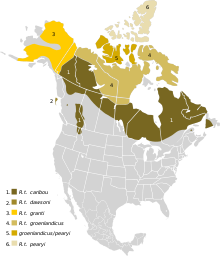| Caribou | |
|---|---|

| |
| Female and calf in British Columbia | |
| Scientific classification | |
| Domain: | Eukaryota |
| Kingdom: | Animalia |
| Phylum: | Chordata |
| Class: | Mammalia |
| Order: | Artiodactyla |
| Family: | Cervidae |
| Subfamily: | Capreolinae |
| Genus: | Rangifer |
| Species: | |
| Subspecies: | R. t. caribou
|
| Trinomial name | |
| Rangifer tarandus caribou (Gmelin, 1788)
| |

| |
| Approximate range of Rangifer tarandus caribou in dark brown. Overlap with other subspecies of caribou is possible for contiguous range. 1.Rangifer tarandus caribou subdivided into ecotypes: woodland (boreal), woodland (migratory) and woodland (montane), 2. R. t. dawsoni (extinct 1908), 3. R. t. granti, 4. R. t. groenlandicus, 5. R. t. groenlandicus/pearyi, 6. R. t. pearyi | |
The migratory woodland caribou refers to two herds of Rangifer tarandus (known as caribou in North America) that are included in the migratory woodland ecotype of the subspecies Rangifer tarandus caribou or woodland caribou[1][2] that live in Nunavik, Quebec, and Labrador: the Leaf River caribou herd (LRCH)[3][4] and the George River caribou herd (GRCH) south of Ungava Bay. Rangifer tarandus caribou is further divided into three ecotypes: the migratory barren-ground ecotype, the mountain ecotype or woodland (montane) and the forest-dwelling ecotype (boreal woodland caribou). According to researchers,[5] the "George River herd which morphologically and genetically belong to the woodland caribou subspecies, at one time represented the largest caribou herd in the world and migrating thousands of kilometers from boreal forest to open tundra, where most females calve within a three-week period. This behaviour is more like barren-ground caribou subspecies." They argued that "understanding ecotype in relation to existing ecological constraints and releases may be more important than the taxonomic relationships between populations."[6][7][7] The migratory George River caribou herd travel thousands of kilometres moving from wintering grounds to calving grounds near the Inuit hamlet of Kangiqsualujjuaq, Nunavik (also known as George River hamlet).[8] In Nunavik and Labrador, the caribou population varies considerably with their numbers peaking in the later decades of each of the 18th, 19th and 20th centuries. In 1984, about 10,000 caribou of the George River herd drowned during their bi-annual crossing of the Caniapiscau River during the James Bay Hydro Project flooding operation.[9] The most recent decline at the turn of the 20th century caused much hardship for the Inuit and Cree communities of Nunavik, who hunt them for subsistence.[10][11]
While the woodland caribou, Rangifer tarandus caribou (boreal population), boreal woodland caribou or boreal caribou, which is mainly sedentary, was assessed in May 2002 as threatened by the Committee on the Status of Endangered Wildlife in Canada (COSEWIC),[12][13][14] not all herds and populations are endangered. For example, the Gros Morne National Park sedentary herd in insular Newfoundland is not endangered.
- ^ Wilson & Reeder 2005.
- ^ Geist 2007.
- ^ Couturier et al. 2004.
- ^ Nunatsiaq News 2011.
- ^ Mallory FF, Hillis TL (1998) Demographic characteristics of circumpolar caribou populations: ecotypes, ecological constraints/releases, and population dynamics. Rangifer Special Issue 10: 9-60.
- ^ Mallory & Hillis 1998, p. 49.
- ^ a b Courtois et al. 2003, p. 399.
- ^ Berkes 1988.
- ^ Makivik 2013.
- ^ Nunatsiaq News 2012.
- ^ Environment Canada 2012.
- ^ Lunn 2013.
- ^ Canadian Parks and Wilderness Society and The David Suzuki Foundation 2013.